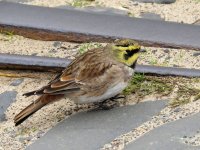Nutcracker
Stop Brexit!
According to Svensson's Identification Guide to European Passerines, moult of Eremophila alpestris is "Adult and young: summer complete". So in autumn, they should be in fresh plumage with their 'horns' at their longest.
Yet in autumn (pic below; mid October), the horns are very short, barely visible, while in spring (when they ought to be at their shortest), they are at their longest and most visible.
What gives? How do their 'horns' get longer in spring? An overlooked partial moult?
Yet in autumn (pic below; mid October), the horns are very short, barely visible, while in spring (when they ought to be at their shortest), they are at their longest and most visible.
What gives? How do their 'horns' get longer in spring? An overlooked partial moult?




